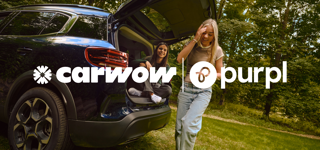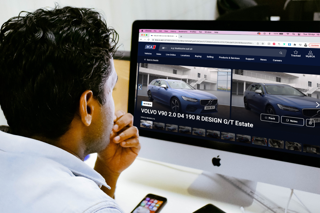Independent dealers may lack the marketing budgets of the major franchised dealer groups, but that needn’t be an obstacle to success. Many can act more quickly and innovatively to raise their profile and put their stock in front of prospective customers. We’ve gathered top tips from motor industry digital marketing experts that will help to boost used car sales.
 Raise the business’s profile in online search
Raise the business’s profile in online search
According to Google’s research, 58% of used car customers buy a car within a month of beginning their search. By the middle of that search, 61% have already been in touch with a dealership.
Hugh Dickerson, Google senior industry head of automotive, said this shows the dealer’s role starts at the beginning of the consumer’s online research, so their digital forecourt needs to be easily found.
Google data showed only 17% of potential customers know exactly the car they want, and only 43% buy from the brand they initially desired, so there is an opportunity for the dealer to capture a consumer’s business.
To cater for this, Dickerson said, dealers should also consider changing their websites’ search mechanisms to make it easier for consumers to see what cars might suit their needs. Also, rather than battle nationally for the most common search words, consider tailoring web pages for specific search terms consumers will use such as ‘low-cost cars’, ‘ideal first cars’ or for search based on the locality.
 Suit smartphones
Suit smartphones
A dealer’s website can be like a needle in a haystack, so to be successful it needs to be visible, optimised for smartphones and simple for the consumer to use. Prospective used car buyers may visit up to 10 websites in their search phase, but visit just an average of two used car forecourts before buying, according to Auto Trader research. Nick King, Auto Trader’s market research director, said this shows that if the online experience is awkward or they feel ignored, they will move on.
King said the smartphone is now the consumer’s internet access point. They are using it to look for range and availability of stock, the dealership’s opening hours, address and contact details. Many customers turn up at the dealership without an appointment, expecting to see a car they found online.
Dickerson added: “If you’ve not got a mobile website, it’s akin to being closed two or three days per week.”
Dermot Kelleher, marketing and business intelligence director at Motors.co.uk, said about 73% of UK adults own a smartphone, so dealers must have a mobile- and tablet-enabled website: “The days of consumers being happy to pinch and zoom to see your website’s content are gone.”
 Track your own website’s users
Track your own website’s users
Tagging each part of a dealer’s website with Google Analytics means every click can be monitored to improve the site, understand how consumers are using it, what makes and models are winning their attention and drive more online visitors to make an enquiry.
Such tracking recently enabled one dealer to discover its customers like to print out the information about the cars they are viewing. This led the dealer to reposition a prominent print button beside every car listed on its website.
Andy Coulthurst, managing director of Motors.co.uk, said independent dealers should look at the UK’s car
supermarkets as examples of how to use analytics and measure response and return on investment in marketing, such as what advertising drives people to their website. A large proportion of independents still admit they don’t measure their marketing but simply “know what works”, he said.
“There is a lot of opportunity to further enhance analysis with independents and help them understand what is working.”
 Spend time on the stock listing
Spend time on the stock listing
It doesn’t take long on classified used car sites to find stock listed for sale with either no photos or just two or three, blanked-out registration plates, and badly taken images – occasionally even posted upside down – accompanied by incomplete information and spelling mistakes, which looks far from professional and will turn off some customers.
Equally, some dealers appear to consider listing details such as a three-spoke steering wheel and cigarette lighter early in the description as more attention-grabbing than a car’s parking sensors, air-con, Bluetooth and full service history. King advises dealers to include at least 10 images of each car for sale and to be clear with the vehicle descriptions, including headline-grabbers aligned with buyers’ key wants.
 Cut the jargon
Cut the jargon
Consumers who engage with the motor trade only every few years when they need to change their used car are less likely to understand jargon such as ESP, privacy glass, brake assist or Dualdrive PAS. Keep it simple.
 Price right
Price right
Analytics offered by the UK’s classified website providers can support the dealership in ensuring used car stock remains priced competitively in order to feature early in the consumer’s search and sell quickly. One in three dealers still doesn’t re-price advertised cars before 60 days, but systems such as Auto Trader’s iControl and Glass’s Radar support the dealer in improving price position, stock turn and overall profitability.
At Motors.co.uk, a ‘reduced cars’ tab on its homepage enables dealers to highlight their latest price reductions, particularly useful for overage stock, and to appeal to the consumer’s desire for a bargain.
 Engage with live chat and social media
Engage with live chat and social media
One in two prospective buyers now searches online for used cars in the evenings, when showrooms are typically closed. However, operating live chat and social media services into the evening ensures the dealership can still engage the consumer at this crucial point if they require more information.
Nevertheless, the advice of Ray Harkin, operations director at sales training group Martec Europe, is to move at the customer’s pace and to not respond to enquiries with immediate requests for their personal details because online consumers are often cautious of the hard sell. A dealer should also ensure it matches the most popular ways customers are using to reach out. Harkin recounted meeting a dealership salesman who said if a customer didn’t include a telephone number in a web enquiry he wouldn’t take it seriously “because the customer wasn’t serious”.
“The salesman didn’t understand that including a number didn’t suit the customer’s lifestyle,” Harkin said. He urged salespeople to never pre-judge a customer on their initial enquiry – every enquiry must be treated as valid and as “precious”.
“If the first thing you do is ask for information on an enquiry, the consumer might not want to continue.”
On live chat and social networks, he advised taking a personal approach rather than working to a script: “be genuinely interested in what the customer has to say”.
 Consider video
Consider video
Short video walkarounds of a car can help it stand out from the crowd on classified websites, but tailored video systems such as those by AutosOnShow, Bluesky Interactive and CitNow, can have an even stronger role to play after a prospective buyer has made contact.
With some used car buyers willing to travel 100 miles or more for their ideal car, a dealership that offers to email them a personalised video of the car they’re interested in – answering any queries they may have about the car’s condition – will stand out and may reassure them that the journey will be worthwhile.
 Make use of the DMS
Make use of the DMS
With proper use, the DMS can keep used vehicle stock live, and use it to populate
classified websites and social media. It can improve the process of work being done, such as tracking through preparation and valeting, pricing, photography and video. It can provide management of complaints and satisfaction surveys so the dealer can identify the metrics and measure their marketing channels.
The DMS’s CRM solutions should also be used to get a 360-degree view of customer retention and track individual customer spend and profitability.





















Login to comment
Comments
No comments have been made yet.